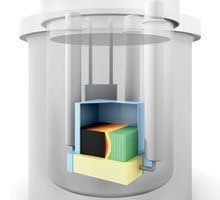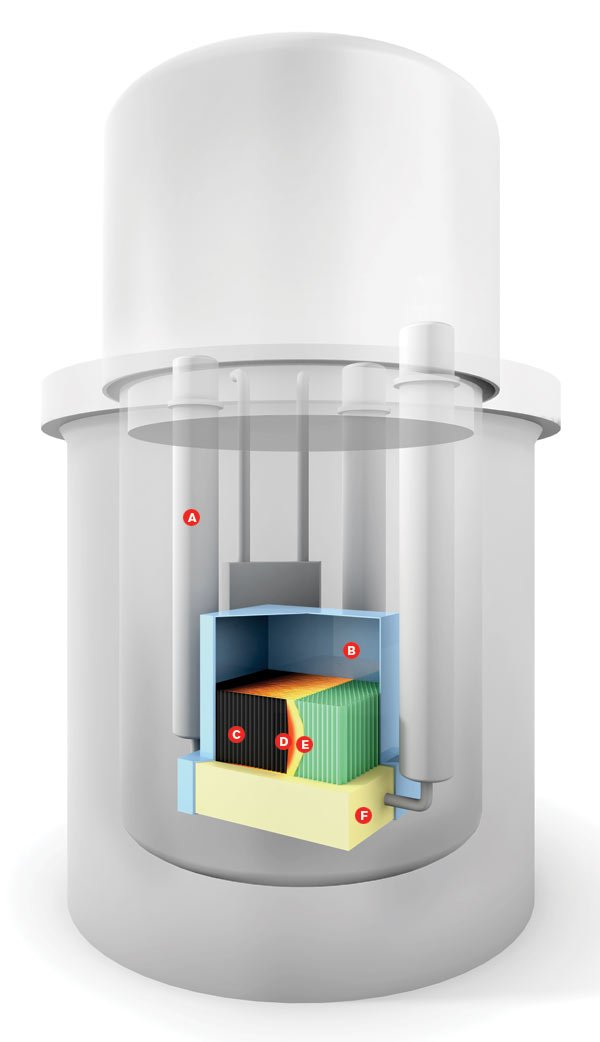Traveling-Wave Reactor

Enriching the uranium for reactor fuel and opening the reactor periodically to refuel it are among the most cumbersome and expensive steps in running a nuclear plant. And after spent fuel is removed from the reactor, reprocessing it to recover usable materials has the same drawbacks, plus two more: the risks of nuclear-weapons proliferation and environmental pollution.
These problems are mostly accepted as a given, but not by a group of researchers at Intellectual Ventures, an invention and investment company in Bellevue, WA. The scientists there have come up with a preliminary design for a reactor that requires only a small amount of enriched fuel–that is, the kind whose atoms can easily be split in a chain reaction. It’s called a traveling-wave reactor. And while government researchers intermittently bring out new reactor designs, the traveling-wave reactor is noteworthy for having come from something that barely exists in the nuclear industry: a privately funded research company.
As it runs, the core in a traveling-wave reactor gradually converts nonfissile material into the fuel it needs. Nuclear reactors based on such designs “theoretically could run for a couple of hundred years” without refueling, says John Gilleland, manager of nuclear programs at Intellectual Ventures.
Gilleland’s aim is to run a nuclear reactor on what is now waste. Conventional reactors use uranium-235, which splits easily to carry on a chain reaction but is scarce and expensive; it must be separated from the more common, nonfissile uranium-238 in special enrichment plants. Every 18 to 24 months, the reactor must be opened, hundreds of fuel bundles removed, hundreds added, and the remainder reshuffled to supply all the fissile uranium needed for the next run. This raises proliferation concerns, since an enrichment plant designed to make low-enriched uranium for a power reactor differs trivially from one that makes highly enriched material for a bomb.
But the traveling-wave reactor needs only a thin layer of enriched U-235. Most of the core is U-238, millions of pounds of which are stockpiled around the world as leftovers from natural uranium after the U-235 has been scavenged. The design provides “the simplest possible fuel cycle,” says Charles W. Forsberg, executive director of the Nuclear Fuel Cycle Project at MIT, “and it requires only one uranium enrichment plant per planet.”
The trick is that the reactor itself will convert the uranium-238 into a usable fuel, plutonium-239. Conventional reactors also produce P-239, but using it requires removing the spent fuel, chopping it up, and chemically extracting the plutonium–a dirty, expensive process that is also a major step toward building an atomic bomb. The traveling-wave reactor produces plutonium and uses it at once, eliminating the possibility of its being diverted for weapons. An active region less than a meter thick moves along the reactor core, breeding new plutonium in front of it.
The traveling-wave idea dates to the early 1990s. However, Gilleland’s team is the first to develop a practical design. Intellectual Ventures has patented the technology; the company says it is in licensing discussions with reactor manufacturers but won’t name them. Although there are still some basic design issues to be worked out–for instance, precise models of how the reactor would behave under accident conditions–Gilleland thinks a commercial unit could be running by the early 2020s.
While Intellectual Ventures has caught the attention of academics, the commercial industry–hoping to stimulate interest in an energy source that doesn’t contribute to global warming–is focused on selling its first reactors in the U.S. in 30 years. The designs it’s proposing, however, are essentially updates on the models operating today. Intellectual Ventures thinks that the traveling-wave design will have more appeal a bit further down the road, when a nuclear renaissance is fully under way and fuel supplies look tight.
“We need a little excitement in the nuclear field,” says Forsberg. “We have too many people working on 1/10th of 1 percent change.”

Keep Reading
Most Popular
Large language models can do jaw-dropping things. But nobody knows exactly why.
And that's a problem. Figuring it out is one of the biggest scientific puzzles of our time and a crucial step towards controlling more powerful future models.
How scientists traced a mysterious covid case back to six toilets
When wastewater surveillance turns into a hunt for a single infected individual, the ethics get tricky.
The problem with plug-in hybrids? Their drivers.
Plug-in hybrids are often sold as a transition to EVs, but new data from Europe shows we’re still underestimating the emissions they produce.
Stay connected
Get the latest updates from
MIT Technology Review
Discover special offers, top stories, upcoming events, and more.